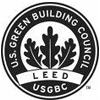
The LEED Standard
What is LEED? |
|
| A green home is designed to have a positive impact on energy efficiency, environmental performance and human wellbeing. LEED (Leadership in Energy and Environmental Design) is the most respected green building rating system in the world. Developed by the U.S. Green Building Council, LEED is a point-based certification system that measures how well a home performs as a green home. |
|
| |
For homebuilders, LEED is a tool used to set targets and track progress during the design and construction of a green home. |
 |
For homebuyers, LEED is a scorecard—like a nutrition label—that gives a clear, concise picture of all the ways a green home performs at a higher level. |
 |
For residents, LEED is a seal of quality, providing peace of mind that they are living in a home designed to deliver fresh air indoors and improved water and energy efficiency. |
What Does LEED Measure? |
|
| LEED recognizes performance in the following primary areas: | |
 |
Indoor Environmental Quality The quality of the air indoors is often two to five times worse, and occasionally more than 100 times worse, than outdoor air, according to the U.S. Environmental Protection Agency. A LEED home is designed to maximize fresh air indoors and minimize exposure to toxins and pollutants. |
 |
Energy Efficiency The average American household spends around $1,500 every year on energy bills, according to the U.S. government’s ENERGY STAR program. Based on average ENERGY STAR scores of LEED homes built so far, they have the potential to use 20-30% less energy, and some up to 60% less energy, than a home built to the International Code Council’s standards for minimum energy efficiency. Less energy use means lower utility bills every month through the life of a house. |
 |
Water Efficiency Wasteful water use is both costly and risky, as population growth and a changing climate make clean, safe water an increasingly scarce resource. It is also directly tied to wasteful energy use: As much as ¼-1/2 of the electricity used by most U.S. cities is consumed at municipal water and wastewater treatment facilities, according to the U.S. Department of Energy. LEED homes use innovative strategies to reduce a home’s water use and to find creative ways to reuse water. |
 |
Site Selection & Development Where you build and how you develop the land can make a big difference. LEED encourages homebuilders to favor communities that strive towards self-reliance, thereby cutting back on commute time. In terms of land development, LEED homes avoid destructive construction practices and have landscaping and other elements that protect the land where the home sits. |
 |
Materials Selection The materials and resources that go into a home can be carefully selected from sustainably harvested, responsibly processed sources – or they can be wasteful and contribute to habitat destruction. LEED homes use recycled, reclaimed and responsibly obtained materials everywhere possible. |
 |
Residents’ Awareness LEED is proactive in educating homeowners and renters about a home’s green features and how to get the highest performance from them. A LEED home also stands as an example to the community of a well-built home and encourages others to live the same. |
 |
Innovation LEED encourages builders and designers to find innovative ways to increase a home’s performance, taking into account local and regional needs and promoting durability for a long-lasting, comfortable home. |
